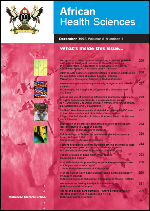
|
African Health Sciences
Makerere University Medical School
ISSN: 1680-6905
EISSN: 1680-6905
Vol. 16, No. 2, 2016, pp. 560-566
|
 Bioline Code: hs16070
Bioline Code: hs16070
Full paper language: English
Document type: Research Article
Document available free of charge
|
|
|
African Health Sciences, Vol. 16, No. 2, 2016, pp. 560-566
| en |
Effects of acute exercise on salivary free insulin-like growth factor 1 and interleukin 10 in sportsmen.
Lasisi, Taye J. & Adeniyi, Ade F.
Abstract
Background: Saliva analysis is rapidly developing as a tool for the assessment of biomarkers of sports training. It remains
poorly understood whether a short bout of sport training can alter some salivary immune biomarkers.
Aim: To investigate the effect of acute exercise using football training session on salivary flow rate, salivary free Insulin-like
Growth Factor-1 (IGF-1) and Interleukin 10 (IL-10).
Methods: Saliva samples were collected before and immediately after a football session. Salivary flow rates, salivary levels of free
IGF-1 and IL-10 (using ELISA) were determined. Data was analyzed and compared using Related Samples Wilcoxon Signed
Rank test (non-parametric test). Relationships between salivary flow rate and levels of free IGF-1 and IL-10 were determined
using Spearman correlation test.
Results: There were 22 male footballers with a mean age of 20.46 years. Salivary flow rate reduced significantly (p = 0.01) after
the training session while salivary levels of free IGF-1 and IL-10 did not show any significant change. Also, there were no correlations
between salivary flow rates and salivary levels of free IGF-1 and IL-10 before and after exercise.
Conclusion: These findings suggest that acute exercise caused significant reduction in salivary flow rate but no change in the
levels of salivary free IGF-1 and IL-10.
Keywords
Saliva, exercise; Insulin-like Growth Factor; interleukin 10; salivary flow rate
|
| |
© Copyright 2016 - African Health Sciences
|
|
